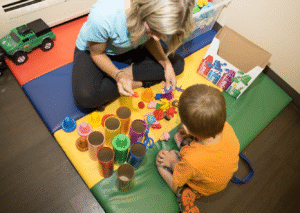Understanding Sensory Integration
Sensory integration is how the brain takes in, organizes, and responds to information from all the senses — sight, sound, touch, taste, smell, movement (vestibular), and body awareness (proprioception). For most people, this process happens automatically, allowing them to navigate the world comfortably. But for individuals with Autism Spectrum Disorder (ASD), sensory processing can work a bit differently.
Many children and adults with ASD experience differences in how they process sensory input. They might be overly sensitive (hypersensitive) to certain sensations or under-sensitive (hyposensitive) to others. For example, a child might cover their ears when a vacuum turns on because the noise feels overwhelming, while an adult might seek out constant movement or deep pressure to feel calm and grounded. These sensory differences can affect everyday routines, social interactions, and emotional regulation, often shaping how a person experiences and engages with their environment.
Common Sensory Challenges in ASD
- Tactile Sensitivity: Discomfort with certain textures, clothing tags, or touch from others.
- Auditory Sensitivity: Difficulty tolerating loud environments like cafeterias or crowded stores.
- Visual Sensitivity: Overwhelm from bright lights or busy patterns.
- Vestibular and Proprioceptive Needs: Seeking movement such as spinning, jumping, or rocking to regulate the body’s sense of balance and position.
- Taste and Smell Sensitivity: Limited food preferences or aversions to strong odors.
These challenges can interfere with learning, play, and participation in everyday activities — making sensory integration therapy a critical part of a comprehensive treatment plan.
The Role of Sensory Integration Therapy
Occupational therapists (OTs) trained in sensory integration use structured, play-based interventions to help individuals regulate and respond more appropriately to sensory input. This therapy takes place in a sensory-rich environment that may include swings, crash pads, textured toys, and weighted equipment.
The goal is to help the brain organize and interpret sensory information more effectively, leading to improvements in:
- Attention and focus
- Emotional regulation
- Motor coordination and balance
- Communication and social engagement
- Daily living skills
For example, a child who is overly sensitive to touch may work with an OT to gradually desensitize through guided exposure, while a teen who seeks movement might engage in proprioceptive or vestibular activities to achieve a sense of calm and focus.
How Sensory Integration Benefits Adults with ASD
While much of the focus is on children, sensory integration therapy also benefits adults with autism. Many adults experience ongoing challenges with sensory regulation that can affect work, relationships, and independence. Targeted interventions can help with stress management, body awareness, and tolerance to sensory environments — improving quality of life and participation in meaningful activities.
Integrating Sensory Support at Home and in the Community
Sensory integration therapy doesn’t stop in the clinic. Families and caregivers are key partners in supporting regulation and growth. Strategies may include:
- Creating sensory-friendly spaces with calm lighting or weighted blankets.
- Using movement breaks during school or work.
- Offering fidget tools for focus and comfort.
- Encouraging predictable routines to reduce sensory overload.
When therapists, families, and educators work together, individuals with ASD can build the skills they need to better understand and navigate their sensory experiences.
How Crawl Walk Jump Run Therapy Clinic Can Help
At Crawl Walk Jump Run, our occupational and physical therapists specialize in sensory integration approaches tailored to each child or adult’s unique needs. Through individualized treatment, we help patients build the sensory foundation necessary for improved learning, communication, and daily functioning.
Our team collaborates closely with families to ensure carryover of sensory strategies at home, school, and in the community — creating long-term success beyond the therapy room.
Take the Next Step
If you or your child struggle with sensory challenges related to autism, early and consistent intervention can make a lasting difference. Contact Crawl Walk Jump Run Therapy Clinic today to schedule an evaluation!




